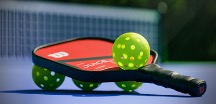PICKLEBALL INJURY PREVENTION TIPS

Pickleball combines restrained low-level volleys mixed with sudden high-level salvos. This can provide terrific athletic challenges and great health benefits. Activities like pickleball support cardiovascular fitness, muscle tone, bone density, balance, coordination, and agility.
Here are some tips to help avoid injury and keep you in top performance.
CLOTHING
Loose fitting (but not baggy) clothes allow optimal joint movement and blood circulation, helping to diminish muscle fatigue and cramping.
SHOES
Outdoor court (tennis) shoes are a must. Indoor court shoes wear out quickly on the outdoor court’s rough surface. Running shoes are made to go in one direction (forward) with little lateral support. The shoe should be low to the ground yet be able to absorb shock, minimizing stress on your feet and knees. The shoe should also fit well to prevent blisters and other foot pains. When’s the last time you actually had your feet measured?
BREATHABLE FABRICS
Clothes made of fabrics that have ‘wicking’ properties are best. They quickly move sweat to its outer surface to dry rapidly, preventing saturation of your clothes and keeping you cool and comfortable.
PADDLES
Grip is the most important part of a pickleball paddle. A too-small grip requires you to squeeze the handle too tightly, causing fatigue which may lead to tendonitis. A too-big grip makes it difficult to hold onto and to change hand positions. Shake hands with your paddle. Your finger and thumb should be about a finger’s width apart. Ultimately, the best grip size is one that is just large enough to play with comfortably and allows for a full range of motion. The handle should be cushioned to absorb shock but remember that a handle wrap will affect the overall grip size.
COURT
Newer courts are typically best. They have fresh lines and no ‘slick’ spots from wear. Check for sand, debris (trash, leaves, sticks) and make sure that you are stable enough to play on that ‘almost dry’ court.
If you’re playing in the late afternoon, turn on the lights a few minutes before you think you need to. And it’s always nice to be on a court that has some nearby shade to take a break in.
LET’S GO!
Before performing any physically challenging activity (pickleball/yardwork/ pumpkin chuckin’) always ready your body by emulating the activity. For pickleball, walk forward then sideways. Look up, down, all around. Stretch up and down. Bend over, sideways and twist. Start the warmup slowly increasing in intensity until you are breathing a bit harder and maybe breaking a slight sweat. If you’re afraid this will make you look silly, do it at home just before leaving for the court. Frankly, I’d rather look silly than nurse my injury from the sidelines.
DRINK UP
Water is a healthier choice than sports drinks. Water is what your body craves most when physically stressed. Unless you’re playing for a long time in the heat and humidity, your body can do without the added sugar, caffeine, etc. that most sports drinks are loaded with. Your body actually has to use more water to push that stuff out of your system than it absorbs.
BEGINNER’S LUCK
If you’re new to the sport, take a lesson or three. There is great value in learning the proper way to do anything – including pickleball. Good form will help you play better, have more fun and avoid injury.
JUST IN CASE
Even with the best preventive measures pain and injury can happen with any sport. If you experience pain or injury beyond simple muscle soreness Dr. Hall is uniquely trained to treat common pickleball injuries, such as tennis elbow, shoulder injuries, low back pain, sprained ankles and knees. He is an expert at both sports injury prevention and rehabilitation.
For more information about Hall Chiropractic visit our website at www.fortmill-chiropractor.com, call or text Hall Chiropractic at 803.412.2240 today for your FREE Health Consultation.
Posted In:
Chiropractic Care
Exercise
